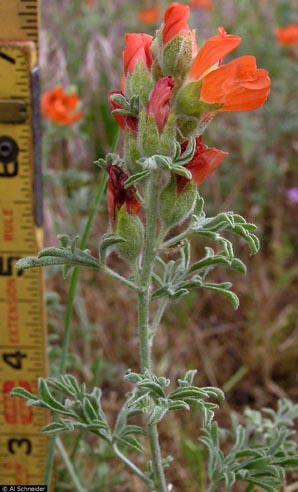Scarlet Globemallow

Common Name(s):
Scarlet Globemallow
Slippery Elm
Scientific Name:
Sphaeralcea coccinea (Pursh) Rydb.
Scientific Name Synonyms:
None Known
Symbol:
SPCO
Description:
Life Span: Perennial
Origin: Native
Season: Cool
Growth Characteristics: Hairy, several -stemmed forbs, which grow from a woody base. The stems are erect, reaching heights of up to 2 ½ feet tall. Flowers April to August, and reproduces from seeds.
Flowers/Inflorescence: Petals deep orange or brick red to pinkish. They are short stalked, at first crowded into dense terminal clusters, later elongating.
Fruits/Seeds: Fruit is a Schizocarp.
Leaves: Palmately shaped, with 3-5 deep cleft lobes. Because they are covered with star-shaped (stellate) hairs, the leaves have a rough, sandpaper-like texture.
Ecological Adaptions:
Scarlet globemallow grows mainly in dry grassland prairies at elevations of 3,500 to 9,000 feet. It is considerably drought resistant and establishes well on disturbed sites. It loses its leaves during times of drought and may actually increase in size in times of drought and overgrazing.
Soils: Adapted to a broad range of soils.
Associated Species: Shadscale, cheatgrass, big sagebrush, winterfat.
Uses and Management:
Scarlet globemallow is commonly eaten by almost all species of herbivores and is an important part of the diets of small mammals, pronghorn, sheep, and cattle.
Blackfoot Indians chewed these plants and applied the paste to burns, scalds, and external sores as a cooling agent.

